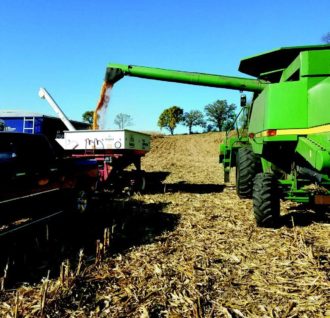Cover crops can improve a farmer’s bottom line in many ways, whether it’s by lowering fertilizer needs, reducing weed and pest pressure, or boosting yields, but as with any investment, there are things to take into consideration when planning. Jim Stute is a farmer in southeast Wisconsin, and a crop and soil researcher with the Michael Fields Agricultural Institute (MFAI), and he’s been experimenting with cover crops for about 30 years. With support from a $29,355 NCR-SARE Partnership grant, Stute is currently partnering with five-grain farmers to collect data to determine the impact of various cover crops on crop yield and bottom lines. He has been using partial budget analysis, factoring in all additional costs and returns, to determine the effect on farm profitability.
“Farmers recognize soil health benefits of cover crops, yet are weighing every input purchase in the current market environment and may forgo this production expense at the risk of soil and environmental quality,” said Stute. “SARE funded work has demonstrated yield benefits to crops which follow covers; we will document and demonstrate them at the local level and provide a financial incentive for adoption.”
Strip-trials were conducted with and without cover crops using the partnering farmers’ cover crop of choice. The farmers, who are experienced cover crop users, followed routine field practices for establishing and terminating the cover crop. Their findings, thus far, have indicated:
- Use of covers increased grain yield in 10 of 14 cases (71%), however, yield increases were statistically significant in only 2 cases (14%). On average, cover crop use increased yield 2.2%, 2.1% for corn, 2.3% for soybean.
- Under current market conditions, grain yield increase resulted in a positive net return in only 1 case and on average, a 5.5% yield increase is necessary to breakeven.
- Yield increases had the net effect of reducing cover crop cost 57.7% across numerous cover crop systems.
"Results of this study demonstrate that cover crops can have a positive impact on crop yield and their use can result in a net return under the right circumstances," said Stute. "Even when positive yield response doesn’t result in a net return, it has the effect of reducing cover crop cost. This study was not designed to determine the cause of positive yield response, only measure it and causation requires further investigation to develop best management practices which could increase adoption through financial incentives."
Stute wants to use the information they gathered to help encourage producers to adopt cover crops in order to protect soil and water resources in the region.
“Our group is in process of forming a formal farmer-led watershed group to work broadly in the Rock River Basin, concentrated in the Mudcreek-Scuppernong sub-watersheds," said Stute. "The groups' still-evolving goals are to reduce phosphorus loading into the impaired surface waters (Wisconsin Dept. of Natural Resources declared) and unraveling the causes of yield increase due to cover crop use with the ultimate goal of increasing adoption."
